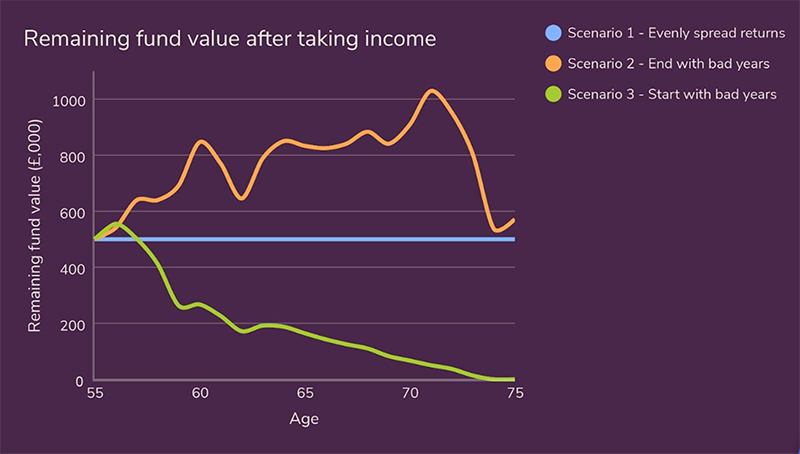You’ve spent decades building up your pension. As retirement nears, and it comes to the point that you want to draw an income, another challenge emerges: how do you convert those savings into a sustainable income, an income that lasts a lifetime?
This can be a delicate time. Your decisions on how you invest, what equity:bond mix you should use, and what percentage rate of withdrawal you decide could have a significant impact on how long your pension pot lasts!
Sequencing risk can be a real threat – a little-known (but crucial) factor that could significantly impact the sustainability of your pension. It can dramatically impact how long your money lasts—especially if markets fall early in your retirement.
In this article, I’ll explain sequencing risk, show you what it looks like in practice, and explore the strategies we use at Tandem to help clients navigate it with confidence.
What is Sequencing Risk?
Sequencing risk is the danger that poor investment returns in the early years of retirement, when you start withdrawing from your portfolio, will disproportionately damage your future income. Why? Because you’re selling assets when prices are down, locking in losses and reducing the potential for recovery.
Let’s take an example:
Imagine two retirees, both aged 55, each with £500,000 in their pension and each withdrawing £25,000 (5%) per annum.
- Retiree A experiences a major market crash (e.g. -38%) in the first few years.
- Retiree B experiences the exact same crash in year 15.
Even if they achieve the same long-term average return (say 7.5% per annum), their outcomes will be wildly different.
Retiree A could run out of money by age 80. Retiree B, who enjoyed strong early returns, could still have hundreds of thousands left and his/ her pension pot could last a lifetime.
The image below shows three scenarios. Scenario one is unrealistic when investing (unless solely in cash which isn’t advisable) as it achieves an evenly spread return over the term, showing as 20 years. If one achieves 5% annual net return every year and withdraws the same 5% in arrears (not in advance) every year, then the nominal value of the pension will remain the same as in Scenario one (blue line) BUT the REAL value of the monies will decline due to inflation. Inflation will erode the buying power of this portfolio.
Scenario two in orange, shows good years initially and then a major crash later on at age 70. Scenario 3 in green shows a bad year in the first few years and the portfolio never recovers.
The lesson? Sequence matters. This is where an adviser can add lots of value!
How you draw your money, where you take it from as well as how much you draw, how often and how your portfolio is invested all factor into this equation.
Why “100 Minus Your Age” Doesn’t Work
A common rule of thumb (or has been until recently) to reduce investment risk over time is by using the “100 minus your age” approach. For example, a 20-year-old would hold 80% in equities and a 70-year-old would hold just 30% in equities. While simple, we believe this ideology is outdated.
At Tandem, we know that a 70-year-old could absolutely still be 100% in equities—if they have a plan.
What matters more than age is how soon you need the money. If you have:
- 6–12 months of cash for income,
- Capital set aside for planned spending over 3–5 years, and
- An emergency fund,
…then the rest of your portfolio can remain invested for long-term growth. And when it comes to protecting against inflation, equities (stocks and shares) remain the best defence over the long run. Bonds can provide short-term stability, diversification and can reduce volatility, but may struggle to keep pace with rising costs.
🧭 How to Navigate Sequencing Risk
There are five key strategies we regularly use:
- ⚡️ Cash Buffering – This involves keeping 1–5 years of essential expenses in easy-access cash. During a market decline, you draw from cash instead of selling investments at depressed prices. We tend to hold anywhere up to 12 months of cash on Transact for retirees in the withdrawal phase, so we are not forced to sell assets during market downturns.
- 📊 Dynamic Withdrawal Strategies (explained by Vanguard) – Rather than withdrawing a fixed amount every year regardless of performance, you reduce your income slightly during down markets and increase it during good years. This approach helps preserve the portfolio and gives your investments time to recover—extending the longevity of your retirement savings.
- 🌍 Use Diversification – A well-diversified portfolio spreads your investments across a range of asset classes (e.g. UK and global equities, bonds, and sometimes commercial property). Diversification reduces the impact of any single asset class performing poorly, helping to smooth returns and reduce volatility over time—especially important when you’re regularly withdrawing funds.
- 🏛️ Partial Use of Annuities – While annuities remove market risk by providing guaranteed income, they also reduce flexibility and can limit what you leave behind. We sometimes consider using an annuity to cover basic living expenses (e.g., utility bills, food), while leaving the rest of the portfolio invested for growth and legacy planning. Index-linked annuities are inflation-proofed, whereas level annuities are not.
- 🔁 Regular Reviews – Financial plans are not “set and forget.” Regular review meetings are essential to check whether you’re still on track, especially when markets are volatile or your circumstances change. These reviews allow us to adjust withdrawal levels, rebalance your portfolio, and top up your cash buffer—proactive steps that help mitigate sequencing risk and give you peace of mind.
Flexibility Is Key
The most resilient retirement plans are built not just on diversification, but on flexibility. By adjusting withdrawal rates, maintaining a sensible cash reserve, and keeping a long-term outlook, you greatly reduce the risk of running out of money just because the market dipped early in your retirement.
No two clients are the same. That’s why at Tandem, we work closely with you to understand your goals, risk appetite, and cash flow needs, and tailor a drawdown strategy that aligns with your values.
If you’d like to learn more about managing sequencing risk or building a resilient retirement income strategy, please get in touch.
Until next time!
Disclosures: Investments can go down as well as up. Access to pension funds is normally from age 55 (rising to 57 in 2028). Tax treatment depends on individual circumstances and may change. You should seek regulated financial advice before taking any action with your pension.





